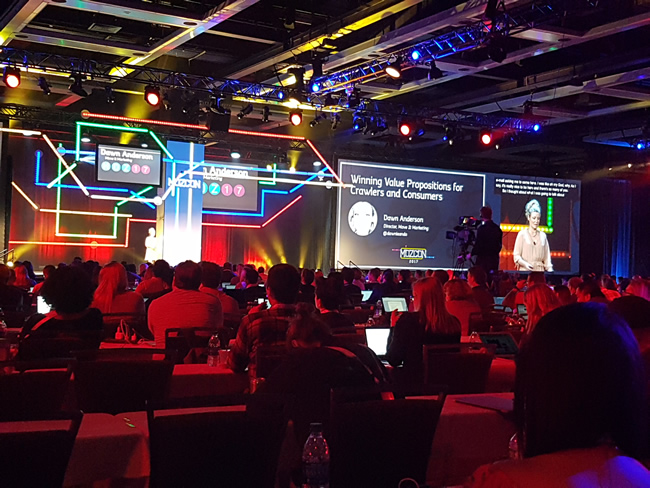DISCLAIMER: This post is written as a live blog from Mozcon. There may be typos and grammar to make my high school English teachers weep. Please excuse those … it’s a fast-paced conference with back-to-back sessions and no time for proofing or even proper writing.
Taking the stage is Dawn Anderson from a UK medical center. After some amusing slides.
She mentions that psycologically we’re built for change. Given the choice between going through a door and not we will go through the door just to see what’s there. Thus browsing is not buying.
Despite being drawn to choice and variety when 2 tables were set out, one with 24 jars of jam and one with 6 – people were attracted to the table with 24 but bought more from the table with 6. We have trouble making decisions with too many choices and this is amplified if we are uncertain in any way and so we defer decision making altogether because it’s easier.
Why Is This?
She refers to the cost of thinking. If the benefit is not high enough ten the cost of thinking about it s not worth it.
She references the cost of 7 in that after 7 choices we increase the odds of not making a decision. Since we want selection then 6 is the magic number of choices to offer.
She also points out that since 200 our attention span has reduced below that of a goldfish.
Tesca had 90k products they were stocking and so people were overwhelmed. Which of 228 air fresheners do you select? They pulled 1/3 of their products to make decision making easier.
Does his translate to digital?
Yes.
And with all the choices we seek shortcuts. They are:
- First or best
- maximizers or satisfiers
- Elimination
How do we cater choosing strategies for ecom?
As soon as we add in consumer divisions making methods (sorting features) can create a nightmare for crawlers with thousands of pages. Thus in ecom (generally) we need a strategy to deal with these types of crawl issue.
This is a massively difficult scenario for Google to deal with (near duplicates) and so it’s a problem for your site.
They then have developer a dustbuster which stops crawlers from crawling dust (low value pages).
A study found that near duplicates are almost always the same as the duplicate they were previously. Thus you can reduce the download priority on near duplicated and save crawler bandwidth.
Finding
Near duplicates cause serious issues (and odd ones). For example with near duplciated a snippet can b drawn from different pages (title from one, data from another, etc).
A big benefit is that if you eliminate or block near duplicates you can control which page Google uses. You will also get a better crawling of your important pages.
Canonical Page
Th canonical can also be used. If you visit RFC 6596 you’ll find everything you need to know about how they work.
With canonicalization it is a suggestion not a directive. 76% of SEOs found it easy to understand, 50% however found that search engines ignored them (at least sometimes).
SEO’s love to give choices vs consumers wanting limited choices.
We thus need to look a scenarios where we can let people make choices.
To please both search engines and people:
Search engine love taxonomies and categorization. So do people. As soon as we label people or products people feel better about the grouping.
We also need to keep the scent going. People will keep searching as long as we keep luring them along (with sub-categories,recommended reading, etc.)
And let people drill down right from the homepage. Google Flights does this, help people drill down quick and easy to refine what they’re looking for.
We can use a variety of techniques to help people. We can color-code groupings, show limited number of items, make getting to sub-categories simple, etc. This reduces choices and increases conversions.
Properly done heading tags can help both users and search engines. Use them as intended and you’ve helped your users and the engines understand how things are broken up to minimize friction.
A quick tip (from a variety of sessions) is to use site search. You an collect data and the use of it aids users and increases conversions.
And don’t forget breadcrumbs. They’re a great label for users and they’re incredibly useful for search engines to understand structure.
XML sitemaps – a thought is to put in only brands and categories on and not products. Products come and go and the brands and categories are the important pages and that’s what Google tells us to do.
The Future
AI and chatbots geared to recommend only a few items convert highly – we need to take their lead.
Remember the display sizes you’re dealing with.
You can download her slide deck here.
